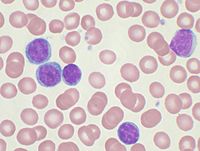
T-Cell Receptor Gene Rearrangement Clonality, Flow Cytometry Status, and Associated Outcomes in Early-Stage Cutaneous T-Cell Lymphoma.
Sign Up to like & getrecommendations! Published in 2021 at "JAMA dermatology"
DOI: 10.1001/jamadermatol.2021.2191
Abstract: Importance The prognostic significance of clonal T-cell receptor (TCR) rearrangement or low-level blood involvement as assessed by flow cytometry for patients with early-stage cutaneous T-cell lymphoma (CTCL) is not clear. Objective To assess the association… read more here.
Keywords: cytometry; early stage; clonality; flow cytometry ... See more keywords

ANPELA: Significantly Enhanced Quantification Tool for Cytometry‐Based Single‐Cell Proteomics (Adv. Sci. 15/2023)
Sign Up to like & getrecommendations! Published in 2023 at "Advanced Science"
DOI: 10.1002/advs.202207061
Abstract: ANPELA is widely used for quantifying traditional bulk proteomic data. Recently, there is a clear shift from bulk proteomics to the single‐cell ones (SCP), for which powerful cytometry techniques demonstrate the fantastic capacity of capturing… read more here.
Keywords: significantly enhanced; quantification; anpela; single cell ... See more keywords

Dual-layered hydrogels allow complete genome recovery with nucleic acid cytometry
Sign Up to like & getrecommendations! Published in 2022 at "Biotechnology journal"
DOI: 10.1002/biot.202100483
Abstract: Targeting specific cells for sequencing is important for applications in cancer, microbiology, and infectious disease. Nucleic acid cytometry (NAC) is a powerful approach for accomplishing this because it allows specific cells to be isolated based… read more here.
Keywords: hydrogels allow; dual layered; acid cytometry; nucleic acid ... See more keywords

Wild immunology assessed by multidimensional mass cytometry
Sign Up to like & getrecommendations! Published in 2017 at "Cytometry Part A"
DOI: 10.1002/cyto.a.22906
Abstract: A great part of our knowledge on mammalian immunology has been established in laboratory settings. The use of inbred mouse strains enabled controlled studies of immune cell and molecule functions in defined settings. These studies… read more here.
Keywords: multidimensional mass; mass cytometry; wild immunology; mice ... See more keywords

Flow cytometry based rapid duplexed immunoassay for fusarium mycotoxins
Sign Up to like & getrecommendations! Published in 2017 at "Cytometry Part A"
DOI: 10.1002/cyto.a.23018
Abstract: At small food processing facilities, the most frequently used test to determine if grain‐derived mycotoxin concentrations are compliant with legal limits is the enzyme‐linked immunosorbent assay (ELISA). Each kit is designed to detect one of… read more here.
Keywords: based rapid; duplexed immunoassay; flow cytometry; rapid duplexed ... See more keywords

Mass cytometry: The time to settle down
Sign Up to like & getrecommendations! Published in 2017 at "Cytometry Part A"
DOI: 10.1002/cyto.a.23032
Abstract: MASS cytometry (CyTOF) technology was first described by Bandura et al. in 2009 (1) boosting the number of measurable markers per single cell and revolutionizing the flow cytometry field toward a horizon of a theoretical… read more here.
Keywords: mass cytometry; cytometry; issue page; flow cytometry ... See more keywords

Statistical performance of image cytometry for DNA, lipids, cytokeratin, & CD45 in a model system for circulation tumor cell detection
Sign Up to like & getrecommendations! Published in 2017 at "Cytometry Part A"
DOI: 10.1002/cyto.a.23144
Abstract: Detection of circulating tumor cells (CTCs) in a blood sample is limited by the sensitivity and specificity of the biomarker panel used to identify CTCs over other blood cells. In this work, we present Bayesian… read more here.
Keywords: image; detection; dna lipids; image cytometry ... See more keywords

Development of a bead‐based multiplexed assay for simultaneous quantification of five bovine cytokines by flow cytometry
Sign Up to like & getrecommendations! Published in 2017 at "Cytometry Part A"
DOI: 10.1002/cyto.a.23170
Abstract: Quantifying cytokines is extremely important in studies of host–pathogen interactions. Multiplex assays are commercially available but only for human and mouse cytokines. Here a method for the simultaneous quantification of five important bovine cytokines IFNγ,… read more here.
Keywords: culture supernatants; bovine cytokines; simultaneous quantification; flow cytometry ... See more keywords

Simultaneous Detection of Protein and mRNA in Jurkat and KG‐1a Cells by Mass Cytometry
Sign Up to like & getrecommendations! Published in 2017 at "Cytometry Part A"
DOI: 10.1002/cyto.a.23281
Abstract: Mass cytometry uniquely enables high‐dimensional single‐cell analysis of complex populations. This recently developed technology is based on inductively coupled time‐of‐flight mass spectrometry for multiplex proteomic analysis of more than 40 markers per cell. The ability… read more here.
Keywords: mass cytometry; detection; simultaneous detection; jurkat cells ... See more keywords

Deconvolution model to resolve cytometric microbial community patterns in flowing waters
Sign Up to like & getrecommendations! Published in 2018 at "Cytometry Part A"
DOI: 10.1002/cyto.a.23304
Abstract: Flow cytometry is suitable to discriminate and quantify aquatic microbial cells within a spectrum of fluorescence and light scatter signals. Using fixed gating and operational settings, we developed a finite distribution mixture model, followed by… read more here.
Keywords: flowing waters; patterns flowing; microbial community; community patterns ... See more keywords

Monitoring circulating prostate cancer cells by in vivo flow cytometry assesses androgen deprivation therapy on metastasis
Sign Up to like & getrecommendations! Published in 2018 at "Cytometry Part A"
DOI: 10.1002/cyto.a.23369
Abstract: It remains controversial whether surgical castration prolongs survival rate and improves therapy prospects in patients suffering from prostate cancer. We used PC3 cell line to establish prostate tumor models. In vivo flow cytometry and ultrasonic… read more here.
Keywords: cytometry; prostate cancer; tumor model; tumor ... See more keywords